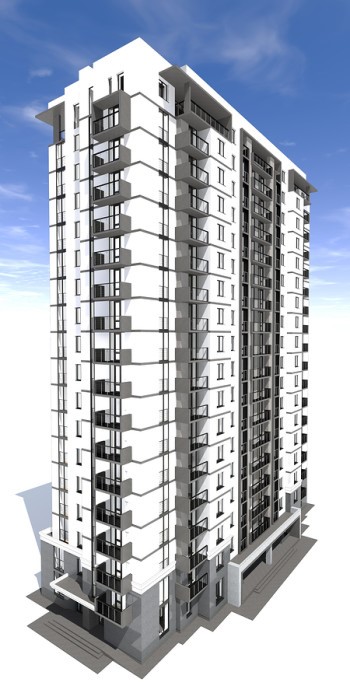مقالات و نوشتار های تحلیلی
پانزده (15) اصطلاحی که در پروسه bim نیاز به دانستن آن دارید...
.Building information modeling (BIM) is gaining momentum with the AEC industry
Governments such as those of the UK, Germany and now Chile are beginning to require BIM for public projects. This momentum makes it increasingly likely that your next project, whether in the US or elsewhere, will require you to become BIM-compliant
For those AEC professionals faced with a requirement for BIM, or who want to use BIM to improve their workflows, we’ve compiled 15 key terms that you should know before you get started
BIM Protocol
?What’s a BIM protocol, you ask
A BIM protocol is a legal agreement that keeps everything on a BIM project moving smoothly. It sets up the role of the Information Manager and any incorporated standards for all team members to follow. It then obliges suppliers to provide BIM data at specified levels of detail and provides necessary protections for producers of information by way of BIM-specific licenses
“It encourages the creation of an infrastructure whereby different parties appointed by an employer are encouraged to share digital information,” said Simon Rawlinson, head of strategic research and insight at Arcadis UK and member of the Construction Industry Council and the BIM Task Group.
“It gives licenses for people to use drawings and documents,” Rawlinson, who was involved in the creation of the original UK BIM strategy between 2009 and 2011, continued. “We wanted to manage some of the risks and liabilities [associated with] the data that sits underneath those models and make sure people had the rights to use the data.”
Rawlinson makes a good point: a BIM protocol helps establish a liability chain so that if there is an error in the data, it would be possible to trace back to the person who made the original error.
It’s important to note that this protocol has different requirements depending on jurisdiction. For example, according to US-based Bentley Systems the BIM protocol serves the same purpose in the US as in the UK, but isn’t considered a legal agreement.
In summary, you’ll want to set up a BIM protocol before you get started to keep your project on the rails.

Not just for buildings: BIM is also effective in large-scale infrastructure projects like bridges and tunnels.
(Employers Information Requirements (EIR
This pre-tender document covers the appointment of designers and contractors.

With large-scale building projects like the Panzhihua Three-line Construction Museum, an EIR helps stipulate information requirements and data drop timing. (Image courtesy of the Sichuan Provincial Architectural Design and Research Institute.)
“Here you have a situation where an employer is trying to be really clear about the kind of information that they need from their suppliers,” Rawlinson explained. “It’s not just about specific data requirements; it’s also about how that data might be formatted, when it might be produced and what it’s going to be used for.”
“Effectively, a client is stepping up to the plate and being much more explicit about the information that they need to support all of their business processes,” Rawlinson continued.
This means that the EIR outlines stages of the project’s information delivery and any standards and processes that a supplier needs to adopt as part of this delivery. It usually encompasses three different areas
· Technical requirements can include things such as software platforms, the data exchange format, levels of detail and any necessary training.
· Managerial requirements can include things such as stakeholder roles and responsibilities, security, collaboration processes and delivery strategies.
· Commercial requirements can include things such as data drop timing, deliverables and competence assessment.
(Master Information Delivery Plan (MIDP
Think of this as the list of tasks for a BIM project. It will tell you exactly who is doing what and when.
This plan is a required part of the EIR. It enters the picture after contracts have been awarded to suppliers and lists who will be delivering what part of the project information, when it will be delivered and which protocols will be used for each stage.
“The Master Information Delivery Plan summarizes every document, be they models, analysis reports or written reports,” explained Rawlinson. “You’re effectively unpacking all of the information you need to deliver in order for a project to be completed.”
This includes deliverables like:
· Models, drawings or renderings
· Specifications
· Equipment
(BIM Execution Plan (BEP
There are two kinds of BEPs: pre-contract and post-contract. Both types explain details about the implementation of various project information aspects and are extensions of the EIR.
BEPS have a role to play in a client’s selection process. “They are taking into account the effectiveness of the contractors’ BIM capabilities and whether their supply chain can work effectively,” said Rawlinson.
“Rather than asking people to create another bid document, you’re saying ‘As part of your bid proposal, you’re going to demonstrate entirely in a high level of detail how you’re going to run this project from an information management and BIM management perspective,’” Rawlinson continued.
Pre-contract BEPs generally outline tentative plans for development, including capabilities, competence and experience of potential suppliers and collaboration goals.
“The pre-contract BEP is ‘this is what we’re going to do and how we’re going to do it’ in outline to demonstrate capability,” said Rawlinson.
Post-contract BEPs are much more detailed and discuss the specific strategy for project deliverables, including roles and responsibilities, documentation like the MIDP, standard methods and procedures like notation, tolerances and IT systems.
“The post-contract BEP is ‘this is the plan so the team knows exactly how we’re going to do it and this is the benchmark against which we’re going to monitor our performance,” Rawlinson explained.
Common Data Environment (CDE)
The CDE is where all of the BIM magic happens.
As its name suggests, the CDE is a digital collaborative area (whether it’s on the cloud or an on-premise server) where all project information is stored. All team members have access and can make changes where necessary—this reduces the risk of duplication and miscommunication. The CDE is a single source of truth.
The CDE is kept and policed by the Information Manager (indicated in the BIM protocol). Information managers, usually appointed by the client, are responsible for ensuring that protocols are followed and that data is properly secured.
Data Classification
Data classification is likely a familiar topic, but BIM takes it to another level. In many cases, individual companies and organizations will have proprietary ways to classify data, which undermines the entire purpose of BIM.
There are several systems for data classification out there, including those such as MasterFormat, OmniClass Construction Classification System and UNICLASS.
Whether your team chooses one of these or something different altogether, it’s imperative that a project team establishes a consistent approach to data classification and that this approach is shared across all involved stakeholders. This doesn’t just apply to the design team: it includes manufacturing, construction and even international operators.
“Data classifications add structure to data, making it so that the data can be organized, queried and reported on in a systematic manner,” said Andy Smith, solutions executive for buildings at Bentley Systems. “Data classification provides a structure that allows appropriate data to be connected.”
(Project Information Model (PIM
This model, frequently referred to as the digital engineering model, sets up the project as a whole.
“It is a virtualization of the design for visualization and to perform engineering analysis to detail and optimize building systems,” said Smith. “All design disciplines contribute to the model, which is used from design conceptualization through contract document production."
The PIM’s first purpose is as a design intent model that demonstrates how various parties plan to implement their sections of the project. It will include both graphical and non-graphical information.
“One or more models are created by each discipline (civil, structural, architectural, MEP),” said Smith. “Models start with conceptual ideas, massing models and space reservation models that begin to form the idea of the building.”
“The most frequent advice given in the planning process is to start with the end in mind,” Smith continued.
After this stage, it becomes a virtual construction model that contains and federates every object that needs to be manufactured, installed or constructed.
The PIM is generally used during the design and construction planning phases, after which it gets developed into the AIM (below).
Requirements for this model are laid out using the EIR.

Models like the PIM and AIM set up the overall plans and specifications for a building project.
(Asset Information Model (AIM
This information model is generated from the PIM and used to manage, maintain and operate the entire project as it happens. It’s important to note, however, that the AIM can be developed without a PIM if there is an existing asset information system. AIMs are generally used during the operations stage of a BIM project.
The AIM usually includes:
· Data defining the original design intent from the PIM or another pre-existing system.
· 3D models, including documents and metadata.
· Details about ownership, rights and restrictions, surveys and other information.
(LoD (Level of Development/Definition
LoD is another BIM term that can vary depending on regional preferences, but definitions are relatively similar.
“LoD is frequently a reference to the Level of Development Specification published by the BIMForum,” said Smith of the US definition. “The LoD specification can be applied to all phases of a project as a framework for the graphical representation and data to be provided at phase completion.”
In contrast, the AEC (UK) BIM Technology Protocol splits the Level of Definition into level of detail and level of information.
· Level of detail refers to graphical content.
· Level of information refers to non-graphical content.
· According to the UK protocol, “together, the LoD and LoI help to better communicate the expectations of BIM content and clarify the Level of Definition at any point in the design and construction process.”
· In both cases, LoD is intended to control the amount of information being loaded into a project model at any given stage. This will help keep the model from becoming bloated with too much data too soon.
· There’s no standard for timing data drops or LoD because it’s very dependent on the type of project. However, in general it should match up with key decision points in the BIM process. For example, the briefing stage does not require information about installation and maintenance, but the design and operation stages do.

BIM has a role to play in every stage of a building project, from concept to construction to maintenance. Each stage requires different levels of information.
Dimensions
Because BIM handles so many aspects of a building project, it needs a few extra dimensions. While it generally goes up to 5D, Rawlinson quipped that there are as many dimensions as there are ways people can think of to use data.
In terms of BIM:
· 4D refers to time—or specifically, to the scheduling involved in the BIM process. With these schedules, project members and building owners can analyze a project to see how it will function over time. This includes simulations conducted within the BIM model to test a structure’s longevity.
· 5D brings finances into the picture. This is the aspect of BIM that analyzes the pricing of components and services to construct an accurate budget and Bill of Materials.
· 6D and beyond refers to facilities management. When it comes to a building project, this can cover a wide range of things including estates strategies, asset management, master-planning and even renovations.
“There are so many other dimensions around logistics and around how a particular component part might be used,” added Rawlinson.

The Midfield Terminal Building at Abu Dhabi International Airport was designed with 4D modeling to illustrate its lifecycle. (Image courtesy of TAV, Arabtec and the Consolidated Contractors Company Joint Venture.)
(Industry Foundation Class (IFC
IFC is an international standard developed and maintained by buildingSMART. It’s designed to describe building and construction industry data and to facilitate information exchange between various collaborators and types of software.
IFC is an official standard, referred to as ISO 16739. The standard is continually in development, so make sure you have the most recent version!
As of 2013, IFC covers:
· Exchange formats required for a building’s lifecycle phases.
· Exchange formats required by any disciplines involved in these lifecycle phases.
However, it does not cover exchange formats outside of construction, facility maintenance, building engineering or behavioral aspects.
Many types of BIM software such as Revit, AECOsim Building Designer and ARCHICAD provide support for import and export of data to and from IFC.
(COBie (Construction into Operation of Building information exchange
COBie is a structured, non-proprietary data format that focuses on the asset data of a BIM project rather than geometric data. Officially, it’s a subset of the IFC that structures data for handover to an employer or operator in order to facilitate decision making, facilities management and asset management.
This spreadsheet-style database usually includes:
· Equipment lists
· Product data sheets
· Warranties
· Spare parts lists
· Preventative maintenance schedules
COBie is meant to make management of BIM data easy for anyone, regardless of IT capability. However, it is possible that not every BIM software will support this format—so be sure to check your software before deciding on COBie as a delivery tool.
PAS 1192
PAS 1192 is a Publicly Available Specification sponsored by the Construction Industry Council. Its main role is to serve as a framework supporting BIM objectives in the UK.
To do this, PAS 1192 specifies the requirements for reaching BIM standards and sets the foundation for collaboration on BIM-enabled projects, including consistent information standards and data exchange processes.

Standards like the PAS 1192 help outline necessities for BIM use in large projects like Park City in Sao Paulo. (Image courtesy of Engbras.)
“It is a UK standard and it being a PAS, it’s actually the first stage in developing a standard,” said Rawlinson. “Eventually it would become a British Standard and then it might go on to be an ISO standard.”
Because it is specifically tailored for the UK BIM industry, PAS 1192 doesn’t have international sway—but it very easily could.
“The key principles of the PAS […] I think can be exported way beyond the UK,” said Rawlinson. These principles, including a clear definition of information early in the project, play a role in companies like Arcadis that span Europe.
“Various countries are investigating their own BIM mandates [like the PAS 1192] in Europe, Asia and South America,” said Angel Velez, senior principal engineer at Autodesk. “Ideally, we’d like to see these mandates converge and encourage decision makers to communicate with each other to make coherent and consistent worldwide standards.”
PAS 1192 has multiple parts that apply to various stages of overall BIM adoption.
Bew-Richards BIM Maturity Model

The Bew-Richards BIM Maturity Model. (Image courtesy of Mark Bew.)
The Bew-Richards BIM Maturity Model, often referenced colloquially as the “BIM wedge,” is a diagram developed to illustrate the maturity levels of BIM adoption. The four levels, conveniently numbered 0-3, each come with increasing requirements.
· Level 0 describes a 2D CAD workflow that doesn’t incorporate collaboration.
· Level 1 depicts a combination of 2D and 3D CAD with occasional file-based collaboration within disciplines.
· Level 2 incorporates interdisciplinary file-based collaboration and incorporates other aspects of BIM, including the CDE and COBie. In this stage, a project might still be hosted in numerous silos and would need to be federated manually for proper collaboration.
· Level 3 doesn’t have exact specifications as of this writing, but it will describe a fully integrated BIM workflow. This will include aspects such as real-time data for one central model hosted on the cloud.
The diagram was developed by CIC members Mark Bew and Mervyn Richards to clarify these levels in the PAS 1192. Further levels may come into play down the line, but for now Level 3 is the highest attainable level.
NBIMS-US
The National BIM Standard-United States is similar to the PAS 1192, save for a few key differences. Although parts of NBIMS-US are adopted in areas such as the UK and South Korea, the standard is tailored toward a more North American workflow.
Versions of the standard are generated by the National Institute of Building Sciences, which uses a consensus approach—BIM users across the country submit ideas to create a general standard for BIM practices.
It’s important to note that unlike the UK and Germany, the US hasn’t taken any steps toward a national BIM mandate. So where the PAS is part of a required process, the NBIMS-US currently serves as a guideline for those who choose to implement BIM workflows.
However, because it is technically more of a guidance document than part of a mandate, the NBIMS-US doesn’t cover the same scope as the PAS 1192. For example, users will find that it doesn’t cover certain useful terms like PIM and AIM.
Whether AEC professionals are faced with a BIM mandate or simply want to use the process to improve workflows, these 15 terms are essential and their use will only become more prevalent as BIM gains momentum in US-based and international projects.
لطفا جهت بحث و تبادل نظر در خصوص این مقاله تحلیلی به انجمن مربوطه مراجعه فرمائید.


